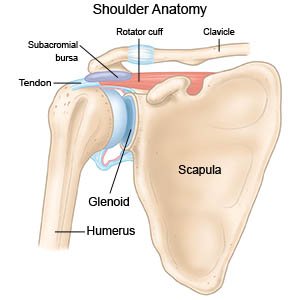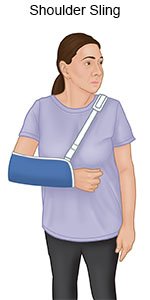Rotator Cuff Tendinitis
Medically reviewed by Drugs.com. Last updated on Aug 4, 2025.
Rotator cuff tendinitis is inflammation of the tendons in your shoulder joint. A tendon is a cord of tough tissue that connects your muscles to your bones. The rotator cuff is made up of a group of muscles and tendons that hold the shoulder joint in place.
 |
DISCHARGE INSTRUCTIONS:
Call your doctor or orthopedist if:
- You have sudden shortness of breath or chest pain.
- Any part of your arm is numb, tingly, cold, blue, or pale.
- You have pain and swelling in your shoulder even after you take pain medicine.
- Your skin is itchy, swollen, or has a rash.
- Your symptoms are not getting better or are getting worse.
- You have questions or concerns about your condition or care.
Medicines:
- NSAIDs help decrease swelling and pain or fever. This medicine is available with or without a doctor's order. NSAIDs can cause stomach bleeding or kidney problems in certain people. If you take blood thinner medicine, always ask your healthcare provider if NSAIDs are safe for you. Always read the medicine label and follow directions.
- Take your medicine as directed. Contact your healthcare provider if you think your medicine is not helping or if you have side effects. Tell your provider if you are allergic to any medicine. Keep a list of the medicines, vitamins, and herbs you take. Include the amounts, and when and why you take them. Bring the list or the pill bottles to follow-up visits. Carry your medicine list with you in case of an emergency.
Self-care:
- Rest as directed. Limit activity on your affected shoulder to decrease stress on the tendon. This may help prevent further damage, decrease pain, and promote healing.
- Apply ice on your shoulder area. Ice helps decrease swelling and pain. Ice may also help prevent tissue damage. Use an ice pack, or put crushed ice in a plastic bag. Cover it with a towel and place it on your shoulder for 15 to 20 minutes every hour or as directed.
- Keep your shoulder in the correct position so it will heal faster. This may be done by increasing the height of armrests while you work, drive, and sit. Try not to sleep on the side of your injured shoulder. If you are a woman, wear a sports bra so that the straps are closer to your neck. This may help decrease stress in the affected shoulder.

Treatment options
The following list of medications are related to or used in the treatment of this condition.
Physical therapy
can help you improve movement and strength, and decrease pain. A physical therapist will teach you safe exercises. The exercises may help you move your shoulder normally again and strengthen your rotator cuff. You may learn changes to make to your daily activities that will help decrease stress on your tendons.
Follow up with your doctor or orthopedist as directed:
Write down your questions so you remember to ask them during your visits.
© Copyright Merative 2025 Information is for End User's use only and may not be sold, redistributed or otherwise used for commercial purposes.
The above information is an educational aid only. It is not intended as medical advice for individual conditions or treatments. Talk to your doctor, nurse or pharmacist before following any medical regimen to see if it is safe and effective for you.
Learn more about Rotator Cuff Tendinitis
Treatment options
Care guides
- Abrasion
- Calcific Tendinitis
- Laceration
- Muscle Strain
- Rotator Cuff Injury
- Rotator Cuff Tendinitis
- Shoulder Dislocation
Symptoms and treatments
Further information
Always consult your healthcare provider to ensure the information displayed on this page applies to your personal circumstances.
